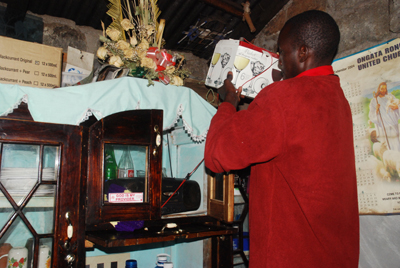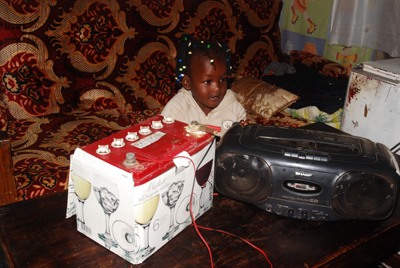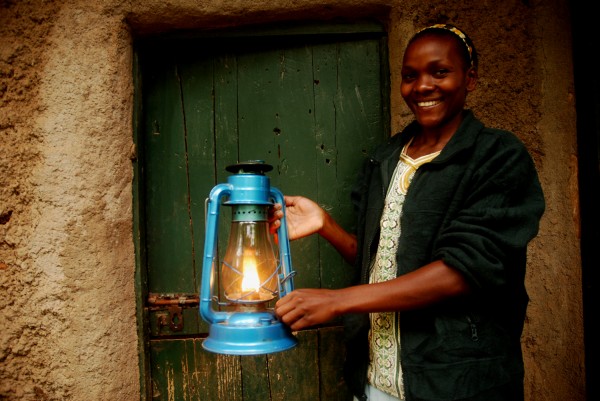Maina, Rhoda and little Winnie are a typical Kenyan family who live on the outskirts of Nairobi in an area that has no electricity.
But they have solved the problem of getting the daily news

When I visited their home I was impressed that despite the lack of electricity, Maina has come up with an innovative solution and is able to keep up with whats going on and listen to his favourite Kikuyu music all day long!

Here’s a better look at the system – a second hand car battery hooked up directly to his radio

The wiring is simple

Fully charged the battery last 2 weeks. To recharge Maina has to take it to a place in town for 24 hours at a cost of Ksh 50 (about 80 cents US. If he were to use ordinary batteries Maina would be paying several hundreds of shillings per month (15$) and creating toxic waste with their disposal (Kenya has no battery disposal system). No wonder used batteries are in such huge demand!

And no wonder this family is smiling!
I’m wondering how much it would cost to hook up Mainas battery to a solar panel and some lights. They currently depend on hurricane lamps. Powered with kerosene these are not only a weak source of light but are dangerous and prone to cause fires.

Got any ideas anyone – can we charge a car battery from solar?
Post note: This story was found while making a video slideshow about this average Kenyan families carbon footprint for WildlifeDirect.


Great story! Yes you can charge a car battery from solar (or any power source) as long as the output from the solar matches the battery (most car batteries where I live are 12V). You may need something to stop the battery from overcharging (that’s true of deep cycle batteries not sure about car ones), or some way to keep an eye on it and disconnect from the solar panel. The limitation of car batteries is that they don’t hold up well to lots of charging and discharging, they’re not built for that. But it’s a good second use for batteries that are too old for cars or are spare.
Seconded, I’ve seen similar systems getting recharged by solar in Nepal.
Thanks Kate – yes these are 12v. I now need to find a cheap solar panel that will do the job..
Well – to charge the batery you need more than 12 V. 14.4 V to be exact.
You will also need a device called “charge controller” that will prevent your battery from overcharging. Overcharging is bad for the battery because it overheats it and the acid inside boils releasing toxic fumes.
There are many version of charge controllers from the sophisticated ones used on cruising yachts to the cheap DIY ones. Probably the best solution for your area is to use the automotive regulator that does exactly the same – it receives the power fromthe car alternator and controls the charging of the batery. Ask any local car mechanic – they know the local name for this device. They can also help you to connect the things properly – just tell them that you will use your solar panel instead of the alternator.
Input voltage to the regulator can be 15 or 16 volts. If in doubt just measure the voltage on your car battery and on the alternator terminals.
Thanks Leonid, makes total sense. I’ll look into that.
As the previous commenters have said, it would be possible to charge a used car battery from solar, but an important thing to remember is cost. Even a small solar panel will cost thousands of shillings, plus thousands more for the charge controler. Then there is the risk of theft. In many cases, it is probably better simply to pay the 50/- for charging the battery.
Goto this site to get a solar panel to recharge your car battery.
http://waterfortheworld.com/products-page/products/solar-panel-20-watts
A windmill connected to an old car generator may be a better solution and I bet would be cheaper than a DIY solar charger.
Along the same lines as the windmill…he obviously has a bike. How about hooking up a generator to the bike wheel to charge?
Well with so many ideas proposed there will definitely have to be a follow up post on this as we test out the various options. Thank you Jon, Tim, David and Brad!
Talk to Dominic or the guys at exide batteries. We installed a solar powered unit for lighting a few years ago in Amos’s house for his wedding present. The panels, wiring, battery and a few lights cost 17,000ksh USD 230 then. Must be cheaper now.
Solar charged the battery and 3 lights were available all night, or one could rig up a radio.
Security of the panel was my concern, but we made it mobile thus it could be brought off the roof and locked in the house if folk were away for many hours.
This post is a good example that sustainability – here: the reuse of an old car battery which will end up on a landfill near Nairobi River with the plastics burned, the acid discharged and the lead sold – isn’t a matter of good-will or conciousness for the environment.
As much as I love the solar panel idea (I’ve used the same setup in the past to power my Kenwood TS430S + diode), I am with Brad that it’s probably cheaper to pay the 50 bob instead of getting an expensive solar panel setup. Yes, they may be cheaper these days, but ~3.750 Kshs are still much more than 100 Kshs / month.
Taking this to another level though, it probably is much better for the environment to have individuals with their toxic & leaking car batteries than a power grid which would need to be set up and thus generate much more waste.
There is an NGO based in Nairobi called SolarAid who run a sunny money project and sell solar products at a low cost. For 2150 Shillings you can get a 1.5W panel, bright bulb, 1000mA battery and a universal charger… might be a good way to get rid of those kerosene lanterns, the amount of money spent on that per month has got to be high.
Thanks tbh I’m trying to find out where they are located so that I can get some systems and to spread the news 🙂
Why not try to make it to an oxfam (or alike) project. People here can fund Oxfam by buying sheep and cows. They call it unwrapped presents
http://www.oxfam.org/en/getinvolved/unwrapped
I’m sure lot’s of people would be willing to sponsor this kind of projects !
I provide low cost pv materials for people to make their own small solar panels.
When sent a postal address in a developing country I send ONE free sample unit with pv module and LED etc.
Then we discuss the nest step
Graham
Here’s how we’ve solved clean water, energy issues in Bunabumali, Uganda http://bunabumalivt.tumblr.com/page/6
This only the start of a much larger initiative and the current set up is being upgraded as we speak.
Seeing he has a bicycle he can rig up a car alternator to it and use that to charge his batteries, even a large DC motor would work. The rear wheels couldn’t touch the ground, have the tire spin the alternator and have that hooked up to the battery.
http://www.ircc.iitb.ac.in/~webadm/update/archives/Issue1_2005/rural_technology1.html
I can’t believe you all think charging a car battery with solar power is something to be figured out. Go to any auto parts store, Canadian Tire, etc. and you can buy a 12V solar charger for $29.95 US. Unless you have a high wattage solar charger, you won’t need a regulator — these small ones are about .5 to 1 amp and keep the charge topped off, but csn fully charge one if left on for a longer period of time.
PV would work for daytime even without the 12 battery, find somebody who can trace the radio circuit to eliminate the final power amplifier circuit and cut those board traces, then add a high impedance speaker, like a piezo speaker found in watches and cheap electronic toys. The sound will loose all bass but it will really stretch the power, probably surpassing the natural discharge rate of the battery.
If Maina can find copper and another soft disimlar metal like zinc or another soft alloy he could hammer together a thermopile to use with his kerosene lamps. The Soviets used these to power radios from WW-II through the early 60’s when batteries were too expensive. 50-100 hammered junctions placed above the flames or in the hot air convection path where a good hot to cold heat movement ratio should power a properly modified radio and have enough electricity left to power several white LED’s at night. It is important to not overheat your thermopile as there is a sweet spot, efficiency and power output drops or worse the metals begin to melt if the whole system gets heat saturated. I doubt an easy to make thermopile will make enough amperage to prevent a major voltage drop when connected to the battery and discharge of the car battery.
Maina must also be told to keep the voltage above 11 volts or else lead sulphate crystals begin to form on the plates of the car battery, these are difficult or impossible to remove in the field leaving a useless battery.
I have used an 18V hand drill to charge 12 volt batteries. If you crank in reverse it will actually generate power rather than take it from the battery. I have hooked the drill to a makeshift hand crank and been able to charge all sorts of small to medium electronic devices. If one could mount this to a windmill or water wheel then you could get some good charge for free. Also the dyno from a electric scooter is generally 24V DC and is an excellent for a small windmill.
One can build a larger solar panel from smaller recycled solar cells (solar lights and calculators and such or broken larger cells) for a fraction of the price. and with a little work a charge controller can be created. I have used small Christmas lights as an expedient charge controller on smaller batteries. You just need to calculate how much lights you need to create the correct amount of draw. Also the extra lights will be nice to use after sundown instead of the hurricane lamps.
Im in the process of switching over to solar energy,know any good resources ?